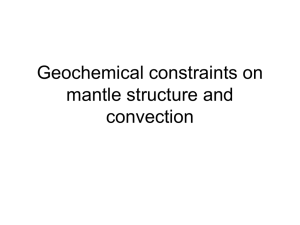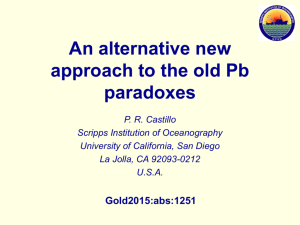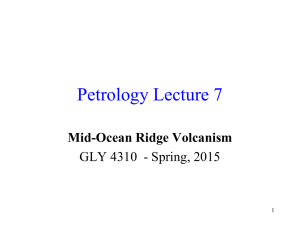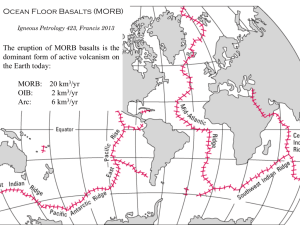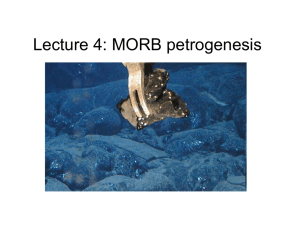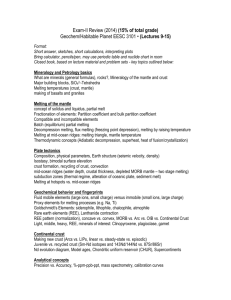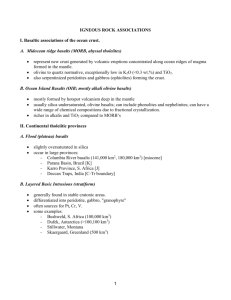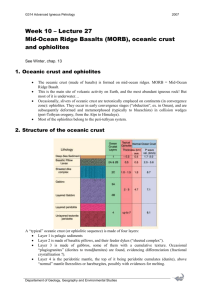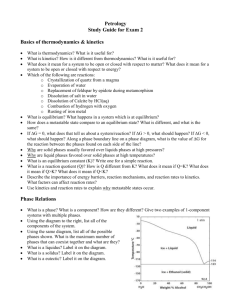IgPetLab8
advertisement
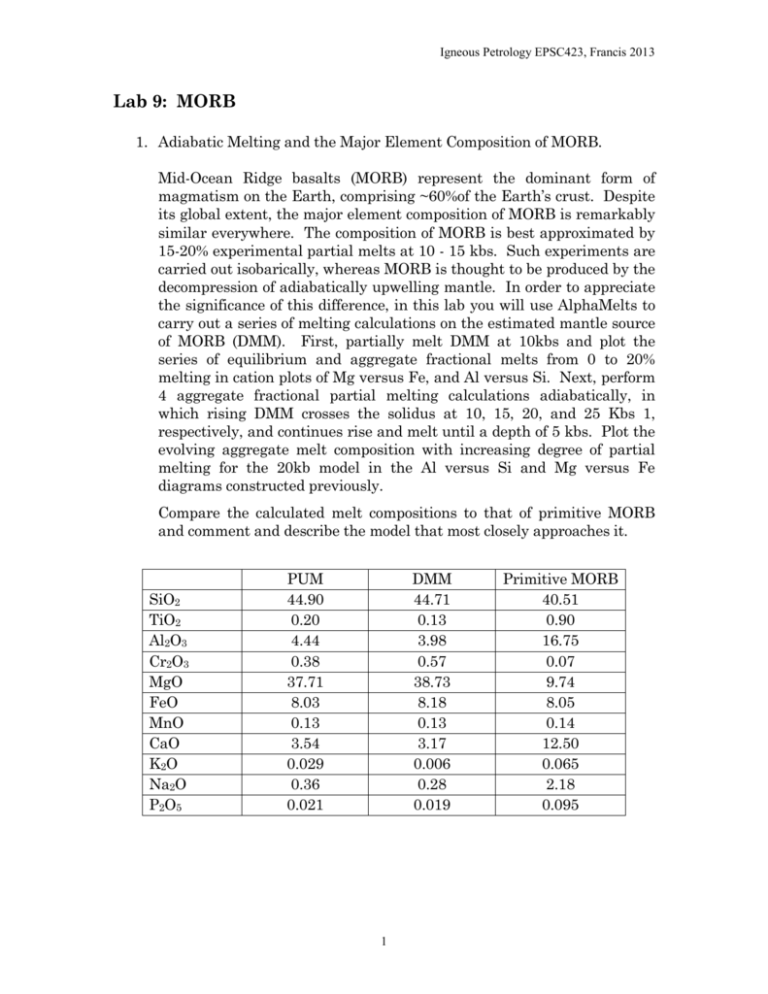
Igneous Petrology EPSC423, Francis 2013 Lab 9: MORB 1. Adiabatic Melting and the Major Element Composition of MORB. Mid-Ocean Ridge basalts (MORB) represent the dominant form of magmatism on the Earth, comprising ~60%of the Earth’s crust. Despite its global extent, the major element composition of MORB is remarkably similar everywhere. The composition of MORB is best approximated by 15-20% experimental partial melts at 10 - 15 kbs. Such experiments are carried out isobarically, whereas MORB is thought to be produced by the decompression of adiabatically upwelling mantle. In order to appreciate the significance of this difference, in this lab you will use AlphaMelts to carry out a series of melting calculations on the estimated mantle source of MORB (DMM). First, partially melt DMM at 10kbs and plot the series of equilibrium and aggregate fractional melts from 0 to 20% melting in cation plots of Mg versus Fe, and Al versus Si. Next, perform 4 aggregate fractional partial melting calculations adiabatically, in which rising DMM crosses the solidus at 10, 15, 20, and 25 Kbs 1, respectively, and continues rise and melt until a depth of 5 kbs. Plot the evolving aggregate melt composition with increasing degree of partial melting for the 20kb model in the Al versus Si and Mg versus Fe diagrams constructed previously. Compare the calculated melt compositions to that of primitive MORB and comment and describe the model that most closely approaches it. SiO2 TiO2 Al2O3 Cr2O3 MgO FeO MnO CaO K2O Na2O P2O5 PUM 44.90 0.20 4.44 0.38 37.71 8.03 0.13 3.54 0.029 0.36 0.021 DMM 44.71 0.13 3.98 0.57 38.73 8.18 0.13 3.17 0.006 0.28 0.019 1 Primitive MORB 40.51 0.90 16.75 0.07 9.74 8.05 0.14 12.50 0.065 2.18 0.095 Igneous Petrology EPSC423, Francis 2013 2. The Trace Element Signature of MORB The chemical variations in MORB are subtle, yet their origins continue to be a matter of active debate. There is typically little variation in the compatible trace element composition of MORB, but a large variation in the incompatible trace element composition. Two end-members can be defined; E and N MORB, the former being enriched in incompatible trace elements compared to the latter. These two MORB types are virtually indistinguishable from a major element or compatible trace element point of view, but have distinct incompatible trace element contents that can not be related by crystal fractionation. In this lab you will evaluate the relative abilities of variable degrees of partial melting to explain the differences between E & N MORB. In the attached table you have been given selected trace element data for E & N MORB, model values for both depleted (DMM) and primitive upper mantle. Plot two spider diagrams in which the trace elements are ordered in terms of increasing bulk Kd, calculated using the mineral Kd's and the source mode given in the table. In the first spider diagram, normalise the trace element compositions of E & N MORB to the composition of the primitive mantle (PUM). In second spider diagram normalise the trace elements of E and N MORB, to the composition of a depleted mantle source (DMM). Using the equations for non-modal melting, calculate the trace element compositions of both the aggregate fractional liquids, and the corresponding residues left behind for the cases of 1, 2, 5, 10, and 20 % partial melting at a pressure of 10Kbs (ie. in the spinel lherzolite stability field). Use the melt mode in the attached table to calculate the factor Po that is required in the relevant equations. Plot your 5 calculated liquid compositions in the two spider diagrams above and, after some reflection, comment on the implications of the results of your calculations for whether the relationship between N & E MORB can be explained by differing degrees of partial melting of a common spinel lherzolite mantle source. 2 Igneous Petrology EPSC423, Francis 2013 Data and Formulae: All values in ppm by weight Primitive Mantle Nb La Sm Zr Y Yb Depleted MORB Mantle 0.66 0.64 0.44 11.4 5.0 0.42 0.15 0.20 0.24 5.00 3.33 0.37 Kd's: Nb La Sm Zr Y Yb E-MORB N-MORB 11.3 10.0 4.0 118.0 24.0 2.3 4.3 2.8 73.0 23.0 3.4 3.3 Oliv Opx Cpx 0.001 0.005 0.005 0.01 0.01 0.01 0.005 0.01 0.01 0.05 0.4 0.05 0.01 0.05 0.20 0.25 0.5 0.40 Source Mode at 10Kbs: olivine 60%, opx 25%, cpx 15% Melt mode at 10 Kbs: olivine 0.0%, opx 30%, cpx 70% Equilibrium partial melt: Ciliq = Cio / (Dio + F × (1-Pi)) Aggregate fractional melt: Cialiq = Cio × (1 - (1- (Pi × F) / Dio)1/Pi) / F Bulk Kd: Dio = Xα × Kiα + Xβ × Kiβ + ………. Melt Kd: Pi = Pα × Kiα + Pβ × Kiβ + …… References: Wood, B.J., and Fraser, D.G.; 1978: Elementary Thermodynamics for Geologists. Chapter 6, 195-228. Workman, R.K. and Hart, S.R.; 2005: Major and trace element composition of the depleted MORB mantle (DMM). Earth and Planetary Science Letters 231, 53-72. 3
